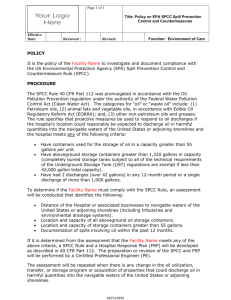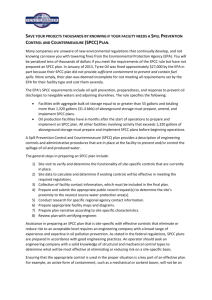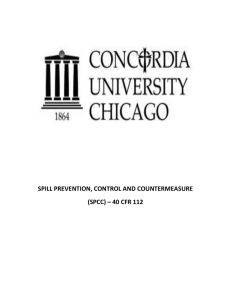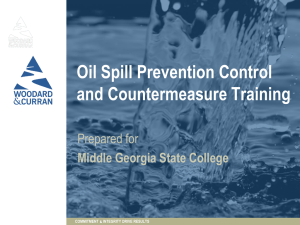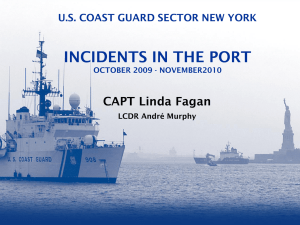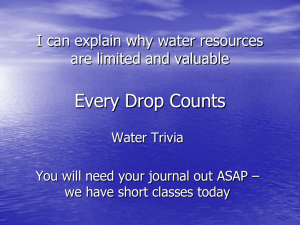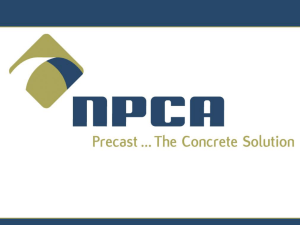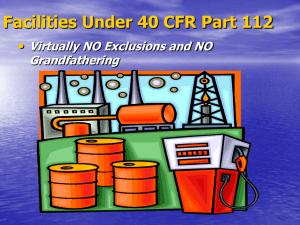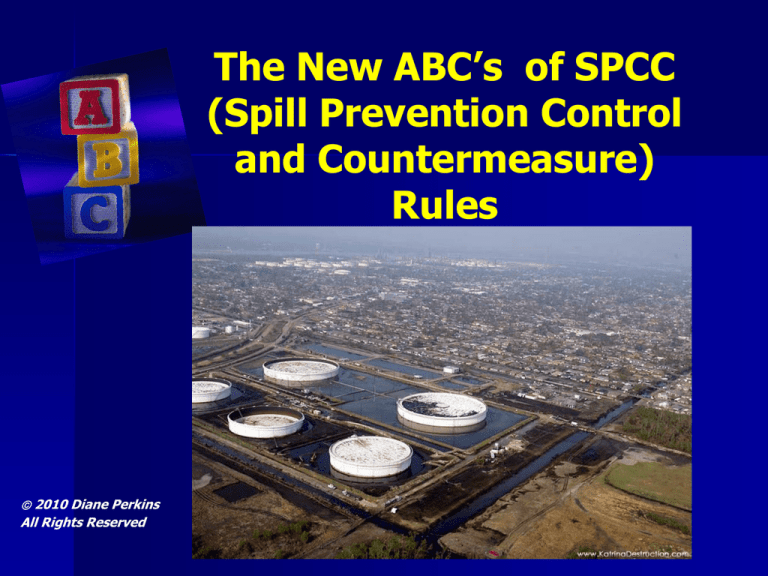
The New ABC’s of SPCC
(Spill Prevention Control
and Countermeasure)
Rules
2010 Diane Perkins
All Rights Reserved
Spill Prevention, Control, and
Countermeasure Rule, 40 CFR 112
Establishes procedures, methods, and
equipment requirements to prevent oil
spills that could reach navigable
waters.
Requires that facilities develop and
implement Spill Prevention, Control,
and Countermeasure (SPCC) Plans.
Applicability
SPCC rules apply to non- DOT facilities
that store, produce, process or use oil
and oil products and that have more
than 31 BBLs (1,320 gallons) of oil
onsite which could discharge harmful
quantities of oil into navigable water or
adjoining shorelines.
Applicability
Includes Facilities with:
– Aboveground tanks
– Completely buried tanks
– Temporary storage tanks
– Bunkered tanks
– Oil filled operational equipment
(e.g. wind turbines, transformers,
hydraulic systems, etc.)
Excluded
– Facilities that could not have a discharge
to navigable water;
– DOT, MMS, DOI facilities;
– Completely buried capacity less <42,000
gallons (Part 280 USTs);
– Aboveground storage capacity <1,320
gallons (Must count 55 gallons drums);
– 55 gallon drums;
– Wastewater treatment facilities.
Also Excluded
– Hot mix asphalt and hot mix asphalt
containers.
– Pesticide application equipment.
– Residential heating oil tanks.
– Diesel USTs at nuclear power plants.
– Non-transportation-related trucks (from
sized secondary containment requirements).
– Motive power containers, aka an automotive
gas tanks.
Definition: Discharge
Term is defined as
including, but not
limited to, any
spilling, leaking,
pumping, pouring,
emitting, emptying
or dumping of oil.
Definition: Harmful Quantity
1. Any amount of oil that violates applicable
water quality standards;
2. Causes a film or sheen upon, or
discoloration of the surface of the water or
adjoining shorelines;
3. Causes a sludge
or emulsion to be deposited
beneath the surface of
the water or upon adjoining
shorelines.
Definition: Navigable Water
Term only includes:
1) All navigable water of the United States
per judicial decisions prior to 1972 and
tributaries of those waters;
2) Interstate waters;
3) Intrastate lakes, rivers, and streams
which are utilized by interstate travelers
for recreational or other purposes;
4) intrastate lakes, rivers and streams
from which fish or shellfish are taken and
sold in interstate commerce.
Background
1972 – Congress passed the Federal
Water Pollution Control Act, amended in
1977 as Clean Water Act, primary
Federal statute for protection of water
resources in U.S. Initial (1973) SPCC
regulations adopted by U.S.
Environmental Protection Agency.
Background (continued)
January 1988: Ashland Oil Company’s 4 million
gallon aboveground storage tank collapsed
spilling 3.8 million gallons of diesel fuel into
Monongahela and Ohio Rivers. Drinking
water supplies impacted for 1 million people in
Pennsylvania, Ohio
and West Virginia.
Background
(continued)
In response to the Ashland oil spill,
EPA formed an SPCC Task Force
to:
Focus on the prevention of large,
catastrophic oil spills.
Make recommendations on the
SPCC program.
Background
(continued)
March 1990: Exxon Valdez spilled 11 million
gallons of crude oil into Prince William
Sound.
In response, Congress enacted the Oil
Pollution Act (OPA’ 90) which, among other
things, required certain oil storage facilities
to prepare Facility Response Plans (FRPs).
Background (continued)
New law led to complete overhaul of SPCC
rules. Series of new rules proposed 1991,
1993, 1994, 1997, and 1999.
2002- New SPCC rules adopted by
U.S. EPA. American Petroleum
Institute et al. sued EPA.
EPA adopted revised rules in 2006,
2008 and 2009 but repeatedly
delayed compliance dates ….
Background (continued)
January 14, 2010: All rules became
effective.
November 10, 2010.*
Compliance date for all facilities (except
new oil production ). New oil production
facilities have up to 6 months after
completion of facility.
http://ecfr.gpoaccess.gov. (Title 40, Part
112)
SPCC Rules Make a Difference
Organization of the SPCC Rule
Subpart A
Subpart B
Subpart C
Subpart D
All facilities and all types of
oil.
Petroleum oils and non
petroleum oils. Except those oils
covered in Subpart C.
Animal fats, oils and
greases, fish and marine oils,
vegetable oils from seeds,
nuts, fruits and kernels
Response Requirements for
Significant and Substantial
Harm Facilities
Significant and Substantial
Harm Facilities
There are special SPCC rules that apply
to “Substantial” and to “Significant and
Substantial” Harm facilities.
Subpart D-Facility Response Plans
(FRPs) rules published 1993 and 2000.
Substantial Harm Facilities
Transfers oil over water to or from
vessels and has a storage capacity
>42,000 gallons.
Significant and Substantial
Harm Facility
Has a total storage capacity > 1,000,000
gallons and:
–
–
–
–
No secondary containment for tanks; or
Proximity to sensitive area; or
Proximity to drinking water intake; or
History of spills
Are You Qualified?
Special rules for self-certification apply to
Qualified Facilities:
Tier I: < 5,000 gallons storage and no single
discharge > 1,000 gallons or 2 discharges >
42 gallons in any 12 month period for past
three years.
Tier II: <10,000 gallons storage and no single
discharge > 1,000 gallons or 2 discharges >
42 gallons in any 12 month period for past
three years.
Devilish Details
SPCC Plan must :
1. Be written;
2. Have full approval of management to
commit resources to implement Plan;
3. Be kept at attended facility;
4. Be available to EPA for on-site review
during normal working hours;
Devilish Details
(continued)
5. Reviewed and amended whenever
changes are made to facility or
procedures;
6. Reviewed every 5 years to include
more effective pollution control
technology (review documented);
7. Be initially certified by a Professional
Engineer (except Tier I or Tier II)
and re-certified whenever amended;
Devilish Details
(continued)
8. SPCC Plans must be submitted to the
US EPA Regional Administrator
whenever a facility has a discharge
of more than 1,000 gallons (23 BBL)
of oil in a single event or discharges
more than 42 gallons (1 BBL) of oil in
each of two discharges in a 12month period.
Primary Components of SPCC Plan
40 CFR 112.7
1. Physical description of facility;
2. Facility Diagram with location, contents
and capacity of fixed containers, drum
storage areas, transfer stations and
connecting pipes, as well as the
location of “exempt” tanks and
pipelines;
Primary Components of SPCC Plan
40 CFR 112
3. Procedures for discharge prevention,
discharge control and routine
handling of oil;
4. Discharge or drainage controls
(dikes, valves);
Primary Components of SPCC Plan
40 CFR 112
5. Procedures for discharge discovery,
response, cleanup and reporting;
6. Contact list and
phone numbers for
facility, NRC, state
and federal agencies, and cleanup
contractors;
Primary Components of SPCC Plan
(continued)
7. Methods of disposal for recovered
materials;
8. Procedures to gather information to
be relayed to National Response
Center; (usually a fact form)
Primary Components of SPCC Plan
(continued)
9. Prediction of direction, rate and quantity
of oil that could be discharged from each
type of major equipment failure;
Primary Components of SPCC Plan
(continued)
10. Requirements to use a form of
secondary containment, diversion
structure, barriers or sorbent
materials to prevent discharge of oil;
Primary Components of SPCC Plan
(continued)
If secondary containment not
practicable:
1.Must perform periodic integrity testing of
bulk storage containers and periodic
integrity and leak testing of valves and
piping;
2.Develop Oil Spill Contingency Plan (40
CFR 109); and
3.Provide written commitment of
manpower, equipment and materials to
remove any quantity of oil discharged that
may be harmful.
Top 3 Secondary Containment
Traps
1. No fixed size (i.e. 110%) or permeability
of wall or floors;
2. No enforceable requirement for amount of
freeboard (i.e. 25 year storm);
3. Must subtract volume
of primary containers
when calculating
volume of secondary
containment;
Primary Components of SPCC Plan
(continued)
11. Procedures for conducting inspections and
tests (records of inspections must be kept
with Plan for 3 years);
12. Designation of person
accountable for discharge
prevention who reports
to management;
Primary Components of SPCC Plan
(continued)
13. Procedures for Personnel Training:
1. Annual training for oil handling
personnel
2. Discharge prevention equipment
operation
3. Pollution control laws and rules
4. General facility operations
5. Contents of SPCC Plan
Primary Components of SPCC Plan
(continued)
14. Description of Facility Security that
includes how:
Valves, starter controls, pumps are
secured from unauthorized access;
Master Flow valves closed/locked
Locked starter controls on pumps
Load lines are capped or blank-flanged
Facility Lighting is appropriate for release
discovery and to prevent vandalism.
Primary Components of SPCC Plan
(continued)
15. Facility tank car and tank truck
loading/unloading racks must include:
1. Containment system for largest single
compartment of tank or truck;
2. Interlocked warning light or warning
signs, wheel chocks, physical barrier or
brake interlock to prevent accidental
disconnect;
3. Inspection of lower drains on vehicles to
prevent discharge.
Primary Components of SPCC Plan
(continued)
16. Evaluation of field constructed
containers for brittle fracture; and
17. Discussion of Plan conformance with
more stringent State rules,
regulations.
November 2009 Amendments
Significant Changes
Prescriptive requirements added for E&P flow
line maintenance program!
Written maintenance program that ensures
flow lines are compatible with fluids, potential
corrosivity, volume, and pressures;
Documented visual inspections on regular
schedule;
Make repairs as indicated by inspections;
Remove, stabilize or remediate ANY
accumulation of oil discharge associated with
flow lines.
The EPA giveth and the EPA
taketh away
Exemption removed for produced water
containers. Secondary containment
requirements now apply to produced
water tanks.
Removed criteria related to stripper wells
from the definition of Qualified Facility.
Tier I and II facilities are defined by oil
storage only. Production status of wells is
irrelevant.
SPCC Rules
A- Are detailed, but reduce oil spills.
B- Became effective 01/14/2010.
C- Contain specific requirements for
procedures, methods and equipment
to prevent the discharge of oil into
navigable water.
Questions?
Cirrus Associates, LLC
Dallas
Houston
1771 International Parkway Suite 107
Richardson, Texas 75081
(972) 680-8555
dperkins@cirrusassociates.com

